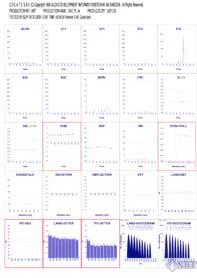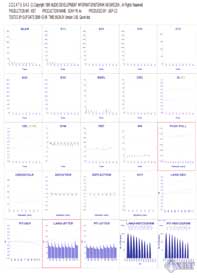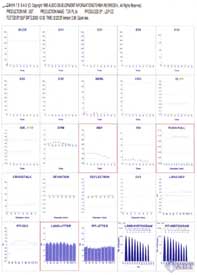 |
||
|
||
| ||
Calculation algorithmError Rate
This parameter defines reliability of information stored on the tested disc. Thus, the less a value, the more reliable the disc for storing data. Mechanical (physical disc properties)
The parameter defines accuracy of the physical properties of the disc (such as deformation). The less a value, the better the disc in terms of physical features). Optical
This parameter characterizes quality of reading of a recorded disc. The less the value, the better and more stable the disc will be read. CD CATS SA3 test printoutsCD-R MMORE test printout (quick testing)  CD-R Basf test printout (full testing)  As you can see, only few results are clear without comments and only for those who are at least a little familiar with the CD-R record technology. The both discs were recorded on the Plextor 12/4/32 SCSI at 8X. A quick testing differs from a full one in amount of received information. The quick testing doesn't give a full-value idea on a disc since there are only 10 points to be measured, 60 seconds for each; they are evenly distributed around the disc and cover 13% of the disc surface. Inaccuracy of results of the both methods is quite small, and with the obtained information we can draw rather definite conclusion. Red color marks out the subtests the results of which should be paid closer attention to, i.e. they oversteps the limits of the norms. Comments on main parametersSuch parameter as BLER (BLock Error Rate) should be already clear for you - it defines measurement of the quantity of data blocks with at least one error (E11+E21+E31). Any other definition - a parameter that characterizes the number of read errors from the surface that was corrected by the CRC block per second. For CD-R the specification indicates 220 errors per second. For comparison - for CD-ROM discs it is 50 errors per second, at maximum equal to 100. The parameter BLER is very critical, since it is a result of calculation of errors on the disc. It means that the lower the BLER of the CD-R, where you have recorded the information, the more reliable the integrity of your data. E11, E21, E31 - the parameters demonstrate how the existent errors are divided into different categories of "rigidity". E11, E21, E31 are calculated as quantity of errors per second. The parameter E11 fixes presence of one-character correctable errors in the first decoder. The parameter E21 fixes presence of two-character correctable errors in the first decoder. The parameter E31 fixes presence of incorrectable errors in the first decoder (C1). E12, E22, E32 - are fixed in the second decoder (C2) and also measured as the number of errors per second. Note that E31 errors can "penetrate" and be fixed in the second decoder, that's why such errors can be identified by the monitoring as the read errors E12, E22 and E32. The parameter E12 fixes presence of one-character correctable errors in the second decoder. The parameter E22 fixes presence of two-character correctable errors in the second decoder. Ideally, the disc mustn't contain such errors since their presence says that the disc has errors close to incorrectable. The parameter E32 fixes presence of incorrectable errors in the first decoder or even unreadable data. E32 mustn't exist on a disc. The BERL parameter (Burst Error Length) fixes the presence of physical defects quite large for getting onto more than one data block (the number of successive ATIP-errors abreast). The BERL is based on the presence of E21 and E31 errors which are evidence of a physical damage. According to the Red Book the BERL for CD-R mustn't exceed 7, and according to the Audio Development recommendation - 5 for CD-ROM. The Orange Book sets more rigid requirements - maximum 3 successive errors. The CRC (Cyclic Redundancy Check) parameter shows the number of blocks per second, where the CRC-errors are detected. The parameter is located on the informational subcode and must be within 0 to 75 blocks per second. The I3, I11 parameters are measured by comparison of levels with analog ones on the reference disc (supplied with the test station) which have the definite values. For CD-ROM the level I3 must be within 0.3 to 0.7, the I11 must exceed 0.6. Due to some reasons, maintenance of these levels on a disc more than 70 minutes is difficult. For CD-R the requirements are softer due to the lower level of reflection tolerance, that's why the I3 and I11 can slightly vary from the recommended ones. Measurement of I3R, I11R parameters provides a possibility to distinguish amplitude modification caused by deformation of pits from amplitude modification caused by light absorption in the substrate and in the reflected layer. The parameter SYM (Symmetry) lets us know how much the pits are longer than the lands. The specification allows the SYM tolerance in the range of +5% to -15%. The REF (Reflectivity) sets the reflectivity of the tested disc. For more precise results the test station is calibrated with a qualitative reference disc. The received REF results are used for fixing changes in reflectivity and normalization of I3R and I11R. According to the specs for CD-R the REF mustn't be lower than 65%. Undoubtedly, the REF for a blank and a recorded disc is different (sometimes, markedly). The parameter RN (Radial noise) means track damage. This parameter fixes how much a track deviates from the standard position. A high RN is caused by presence of defects, e.g. a solid particle, bubbles or mechanical damage, and is characterized by skipping of tracks. The RN is limited by 30 nm within 500 - 2500 Hz. The Push Pull parameter defines an ability of a drive to get on a track. The parameter is measured in 10 points of the informational zone. The most important characteristic is a ratio (NPPR) of the Push Pull signal before and after recording. The test station makes measurements in the recorded and unrecorded zones (the tested disc must be partially recorded, otherwise the NPPR can't be measured) and calculates two values of the Push Pull:
The normalized ratio Push Pull (NPPR) is considered one value for the disc: ratio of the PPb average to the PPa average. It's necessary to have at least one value of the PPa and PPb in order to receive the NPPR. The specification sets PPa from 0.04 to 0.09. Crosstalk - Due to high density of tracks on a disc, an alias from the neighboring tracks is inevitable. The parameter Crosstalk defines how strong the alias "beats" the main signal. The parameter mustn't exceed 40%. The parameters DEV (Deviation) defines physical characteristics (deformation) of a disc. DEV is measured in 10 points with +/- 0.5 mm tolerance. The Deflection parameter defines a radial deviation of a light beam due to asymmetric property. It is measured in 10 points. SVY (Scanning velocity) defines the speed of a pit passing the reading laser beam. SVY is decoded in pretracks, and a recorder is guided by exactly this parameter when working with a pretrack. According to the specification, the SVY must be within 1.2-1.4 meters per second. The scanning velocity must be within the defined range of the rotating speed of the player's drive. The parameter is measured in 10 points of the informational zone. The following parameters determine physical characteristics of a disc. Deviation of the whole surface of a disc and a pit. The parameters Jitter (Land-Jitter and Pit Jitter) fix a standard deviation of pits and lands from their ideal length in the range I3 to I11. The parameters Histogram (Land-Histogram and Pit-Histogram) fix the number of pits and lands which keep within the definite length. Ideally, the columns of a graph must be as narrow as possible and must be positioned abreast, i.e. they shouldn't cover each other. Beside the considered 25 parameters there are so called "static data", which are no less important but are shown in digital form. TRP (Track Pitch). TRP is the distance from the center of one track till the center of the neighboring one. The pitch must be within 1.5 - 1.7 micron. It must be lower than a XT - cross talk - since the latter makes digital measurements less precise. The TRP is very important parameter: if one track is strongly covered by another the player works incorrect and can even buzz on this area. A small step gives a high value of the XT and can lead to loss of a track. A big step makes problems for a player for keeping a track. TRP is measured in 10 points of the informational zone. The result is shown as minimum, average amd maximum value of the pitch. The pitch that does not correspond to the terms is a main problem for three-rayed players. ECC (Eccentricity) is a difference between a geometric center of tracks and geometric center of a disc hole. The eccentricity mustn't exceed ± 70 micron for CD. Measured in one point. For CD-ROM eccentricity must be lower than ± 50 micron, since for these discs a random access is used rarely than for audio CDs. If an eccentricity is higher, the random access time will be higher, since the player will seek for tracks a longer time. Keeping a track can get more difficult in case of damages made by a user. SPD (Start of Program Diameter) is measured according to the ATIP-code. The ATIP-time 00:00 is used as control for SPD searching. SPD is used by a player in order to define the start place of the first track. In case the SPD exceeds the specification limits, it will cause increase in time for searching the beginning of the first track. According to specs, the SPD must be within 49.6 - 50.0 mm of diameter. MID (Maximum Information Diameter) is measured according to the ATIP-code. The Lead in of the ATIP contains the last possible start time of the Lead out which is used for MID measurement on a blank disc. According to specs, the MID must be lower than 116 mm. MID is an important parameter since molding methods and processing increase probability of problems of disc edge covering. MID contains data area and beginning of Lead in, and it sets the end of the disc. In case the MID oversteps the limits of the specification it can lead to some problems such as weakening of HF level and disturbing of signal reading. It can be caused by scratches or prints of fingers on the disc. Print-outs of test resultsHewlett Packard CD-R C4437A2x  4x  8x  SKC CD-R2x  4x  8x  Mirex Gold2x  4x  8x  Philips Silver Premium2x  4x  8x  Sony CDQ-74CN2x  4x  8x  TDK CD-R742x  4x  8x  All images are the references to the full sized printouts
Write a comment below. No registration needed!
|
Platform · Video · Multimedia · Mobile · Other || About us & Privacy policy · Twitter · Facebook Copyright © Byrds Research & Publishing, Ltd., 1997–2011. All rights reserved. |